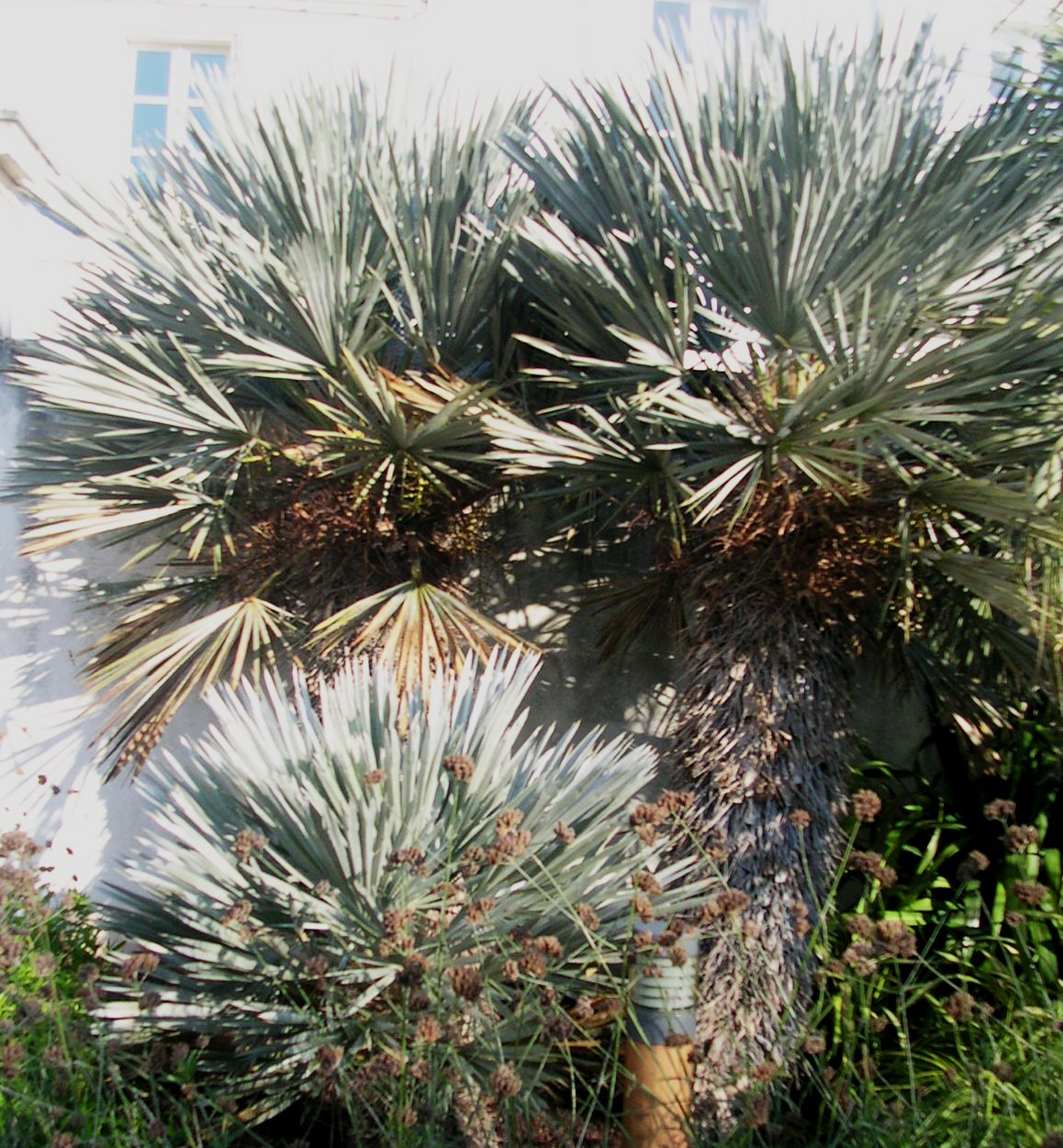- Trithrinax campestris
taxobox
name = Caranday palm
image_caption = "Trithrinax campestris" in a garden, grown as ornamental palm
status = LR/lc
regnum =Plantae
unranked_divisio =Angiosperms
unranked_classis =Monocots
unranked_ordo =Commelinids
ordo =Arecales
familia =Arecaceae
genus = "Trithrinax "
species = "T. campestris"
binomial = "Trithrinax campestris"
binomial_authority = (Burmeist.) Drude & Griseb.
synonyms = Copernicia campestris|"Trithrinax campestris" or "caranday palm" is a
South America narecaceae palm native ofUruguay an and northeastern Argentine sabanas , where it shares its habitat with "Copernicia alba " among others and extends also to the summits of montain ranges ofSierras de Córdoba andSierras de San Luis . It is a very rustic palm that grows in arid, well drained, rocky soils. Its distinctive features are its compact shape, short green to grayish foliage, and trunk fully hidden by dry dead branches (coat) remaining from several previous seasons.Morphology
"T. campestris" is a monocot flowering palm of relative low height (up to 6 m tall) and 20-25 cm wide stems usually covered by remains of earlier foliage that act as a thick protective coat. Caranday leaves are about 1 m long,
palmate , rounded, with a very rigid and spiny petiole., a feature common to the conifers but rare in angiosperms. [Molnar, Sebastian. 2004. [http://www.geocities.com/we_evolve/Plants/breeding_sys.html Plant Reproductive Systems] , internet version posted February 17, 2004]Habitat
"T. campestris" prefers well drained, sandy or rocky soils (although it is ignorant to extended persistent flooding). [Burkart, A. 1979. "Flora ilustrada de Entre Ríos". Col. Cient. INTA VI (5). Buenos Aires.] It is very resistant to drought, and -9°C/-15°C temperatures when not in growing season; else leaves are promptly discarded. It is one of the most cold-hardy palms in the world, this is because it also grows in the montains of
Sierras de Córdoba [cite web | url=http://www.cerrouritorcoam.com.ar/capilladelmonte/aves.html | title=Cerro Uritorco, Sierra de Córdoba] andSierras de San Luis [cite web | url=http://ar.geocities.com/fundacioninticuyum/flora_san_luis.html | title=Flora of San Luis] , it is known that specimens growing at those elevations tolerate special cold conditions. It has thrived as north as theBritish Isles [cite web | url=http://www.dicksonia.com/index.php?id=420 | title=Argentine palm in the British Isles] . Seeds germinate quickly but later growth is mostly slow.This palms are naturally found in groups, formations of several individuals or composing largue caranday forests where they present strong dominance. Its main environmental threat is deforestation or natural fire, caranday thick dry stem coats are highly flammable. [Rojas, A. & Saluso, J.H. 1987. "Informe Climático de la Provincia de Entre Ríos". INTA EEA Paraná,Nº 14. Entre Ríos, Argentina.]
Usage
Leaves are rich in strong fiber, very resistant to tension. It is extracted to manufacture crafts as hats, shoes and fans. Whole leafs are cut and used as rudimentary brushes. Fruits are not eaten, however, an alcoholic beverage is prepared locally through their fermentation.Caranday palms are also appreciated and grown worldwide as an easy to keep, cold weather and drought resistant, ornamental small palm.It is besides a good honey-producing plant [Fagúndez, G. A. y Caccavari, M. A. 2001a. Elementos de mielada en mieles de la provincia de Entre Ríos. XXVIII Jornadas Argentinas de Botánica (Santa Rosa, 2001). Bol. Soc. Argentina Bot . 36 (Supl.): 136.]
External links
* [http://www.scanpalm.no/trithrinax_english.html Scanpalm "Trithrinax"]
* [http://www.plantapalm.com/vpe/photos/Species/trithrinax_campestris.htm Plantapalm]References
Wikimedia Foundation. 2010.
